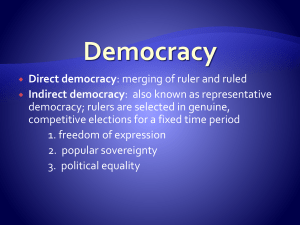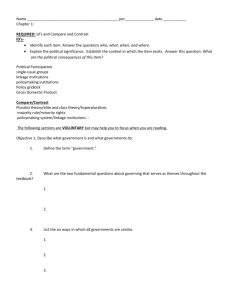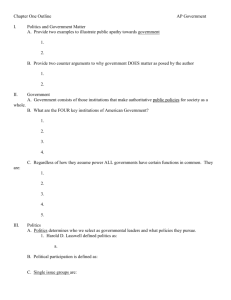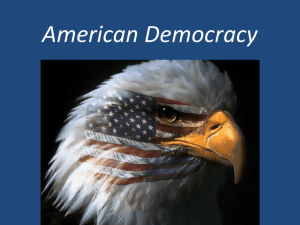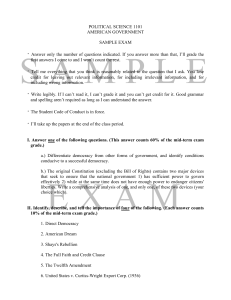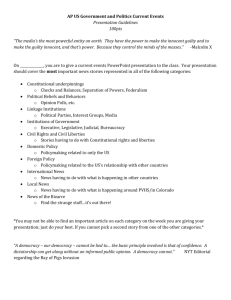Chapter 1
advertisement
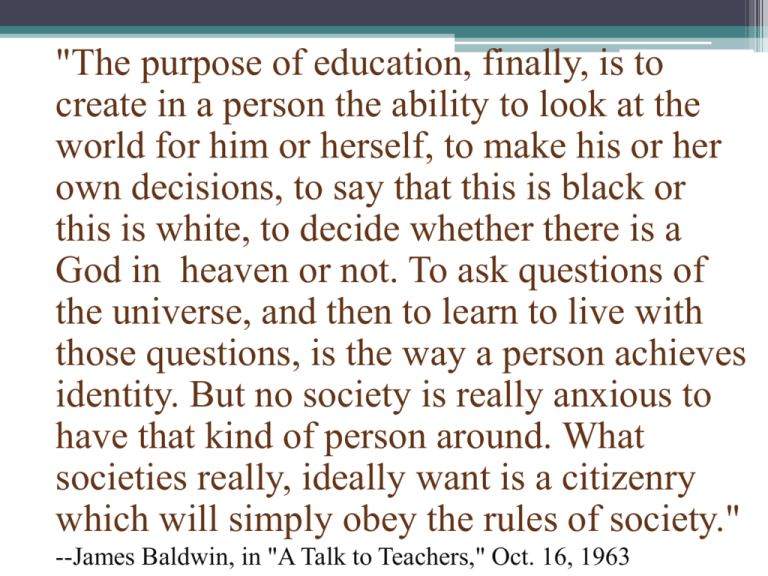
"The purpose of education, finally, is to create in a person the ability to look at the world for him or herself, to make his or her own decisions, to say that this is black or this is white, to decide whether there is a God in heaven or not. To ask questions of the universe, and then to learn to live with those questions, is the way a person achieves identity. But no society is really anxious to have that kind of person around. What societies really, ideally want is a citizenry which will simply obey the rules of society." --James Baldwin, in "A Talk to Teachers," Oct. 16, 1963 2 Unit 1: Constitutional Underpinnings Chapter 1: Introducing Government Political Efficacy • The belief that political participation matters and can make a difference. • Do young people have a low sense of political efficacy? • Why or why not? Government • Institutions (Executive, Legislative, Judicial, Bureaucracy) and processes that make public policy Politics • The process by which we select our government leaders and what policies these leaders produce. Politics produces authoritative decisions about public issues and can be conflicting in nature. The Policy Making Process • Process by which policy comes into being and evolves over time. Linkage Institutions • Political channels through which people’s concerns become political issues on the policy agenda. These include: ▫ ▫ ▫ ▫ Political Parties Elections Media Interest Groups (including single issue groups) Policy Agenda • The issues that government is addressing at a point in time ▫ Items at the top of the policy agenda are taken care of first. ▫ It may take years to get an item on the policy agenda and then several more years to enact policy. Policymaking Institutions • Legislature (Congress) • Executive (President) • Courts (Federal and State) • Bureaucracies (Federal and State) Implementation • Once policy is implemented, feedback occurs: ▫ Effective or ineffective? ▫ Are the resources available? ▫ Does the policy need to be revised/clarified? Democracy • Difficult Definition: ▫ A system of selecting policymakers and of organizing government so that policy represents and responds to the public’s preferences • Easier Definition : ▫ A system with free and fair elections and civil rights and liberties. ▫ Rule by the people ▫ Two types Direct: rule by the people themselves Town hall meetings along the eastern seaboard Ancient Greece Indirect (Representative) United States England Founders' distrust of direct democracy • Impracticalities • Fleeting passions of the people --- > concern that they would be swayed by demagogues (God like attributes). Traditional Democratic Theory • Theory encompasses: 1. equality in voting “one person, one vote” 2. effective participation –equal opportunities 3. Enlightened understanding - plethora of ideas. . . 4. citizen control of the agenda. 5. inclusion of all who are willing to participate. • Majority rule w/ minority rights. An issue of “power” . ▫ Majority = An accumulation of minorities Republic • • • Same as indirect democracy Solves problems of direct democracy Secures the advantages of direct democracy while curing its weaknesses Theories of American Democracy: Distribution of power in our system 1. Elite and Class Theory: • A theory of government and politics contending that societies are divided along class lines and that an upperclass elite will rule. • Policies benefit those with money / power Marxist: inf1luence of economic elites. C. Wright Mills: influence of power elite: corporate, military, political Max Weber: influence of bureaucracy. Theories Con’t 2. Pluralist Theory • A theory of government and policies emphasizing that politics is mainly a competition among groups, each one pressing for its own preferred policies. • Groups with shared interests influence public policy by focusing on organized efforts----they will prevail Pluralist Theory Con’t • Political resources are so scattered that no single elite has a monopoly on them. • There are so many institutions in which power is exercised that no single elite could possibly control all of them. • Policy is therefore the outcome of political haggling, innumerable compromises, and ever-shifting alliances among groups. Theories Con’t 3. Hyperpluralism • “Pluralism gone sour.” • There are so many groups, and they are so strong, that government has become gridlocked and is unable to act. • Governments give in to interest groups and singleissue groups. Political Culture • Political culture is the set of shared values within American society. • Americans share a commitment to democratic government American Political Culture • Liberties (freedoms) • Egalitarianism (equality) • Individualism • Laissez-faire economic policies • Populism---the people • Justice Challenges to Democracy • Increased technical expertise: Power is based on technical knowledge • Limited participation in government: Low voter turnout especially among young voters • Escalating campaign costs: Tremendous costs of even a House seat today greater than $500,000 • Diverse political interests: Difficulty in achieving a majority---POLICY GRIDLOCK Questions About Democracy • Are the people knowledgeable enough about government? • Is low voter turnout a threat to democracy? • Do political parties meet the needs of most American voters? Questions about the Scope of Government • How big a role does the Constitution say should be played by the federal government? • Does a bigger, more involved (active) government limit the people’s freedoms? • Do we need a bigger, more involved government to protect our freedoms? Questions about the Scope of Government, Con’t… • Does the media adequately inform citizens of what is happening in government? Questions about the Scope of Government, Con’t… • Do the federal courts overstep their bounds and intrude on the powers of other branches of government? Questions about the Scope of Government, Con’t… • Are the federal agencies too large and unresponsive to the public they are supposed to serve?
